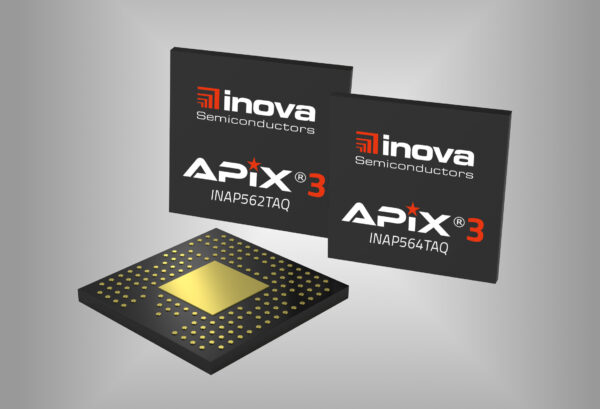Two new APIX3 SerDes TWIN transmitters, each with two independent transmission channels, are now available from Inova Semiconductors. APIX (Automotive Pixel Link) is a multi-channel SerDes (serializer/deserializer) technology developed by Inova for high-resolution video applications in motor vehicles. Typical applications for the new APIX3 chips are infotainment and entertainment systems, as well as instrument clusters and head-up displays in vehicles. The latest APIX3 generation can host multiple display connections with bandwidths of up to 12 Gbps and supports HD and Ultra HD displays.
The latest additions to the APIX3 family are the INAP562TAQ transmitters with HDMI 1.4a (with 3D support) and DSI 1.2 video interface and the INAP564TAQ with two DSI 1.2 video interfaces. Both transmitters differ only in terms of the video inputs and are otherwise compatible. Each of these transmitters can provide two APIX3 links via STP or coaxial cable with the INAP562R receiver already available. This means that one transmitter can control two receivers with completely independent image and data content, which previously required two transmitter devices. This results in reduced system costs and a smaller space requirement on the transmitter-side control unit.
The devices support various EMC-friendly operating modes with fixed bandwidths of 1.5; 3 or 6 Gbps in single-lane mode, with a fixed back channel of 187.5 Mbps.
The new chips of the APIX3 family are designed for popular displays (e.g. 2880 x 1080 x 24 bit, 60 Hz) in cars. But also, video resolutions up to Ultra High Definition (UHD) and color depths up to 30 bits are possible. The available DSI interfaces also allow the transmission of DSC compressed video data with a future-proof available video bandwidth of up to 28.8 Gbps.
The chips enable the simultaneous transmission of up to eight audio channels. A special feature of the APIX technology is the media-independent interface (MII, RMII, RGMII) for 100 Mbit Ethernet according to the IEEE standard. An SPI interface for convenient device configuration and data transmission is also available.
The APIX3 devices are backward compatible with the APIX2 predecessor family and, like these, offer compensation functions for cable ageing and temperature fluctuations. A new feature of APIX3 is the link training of the APIX3 link to the cable medium used. This ensures very robust, stable and optimized transmission. With its many diagnostic capabilities, APIX3 supports safety-related applications and meets the requirements of the automotive industry with regard to electromagnetic immunity and resistance.
Availability
The two new APIX3 transmitters are available now. The chips are qualified to AEC-Q100, operate in a wide temperature range from -40 °C to +105 °C and are supplied by Inova in a 151-pin aQFN package. They are pin-compatible with the already available single-channel APIX3 transmitters INAP563TAQ and INAP565TAQ. The devices are also available as variants with HDCP (High-bandwidth Digital Content Protection). The APIX3 technology has been licensed to Socionext by Inova.
Inova Semiconductors presents the new APIX3 devices at Embedded World 2019 (Hall 3A, Booth 310)















